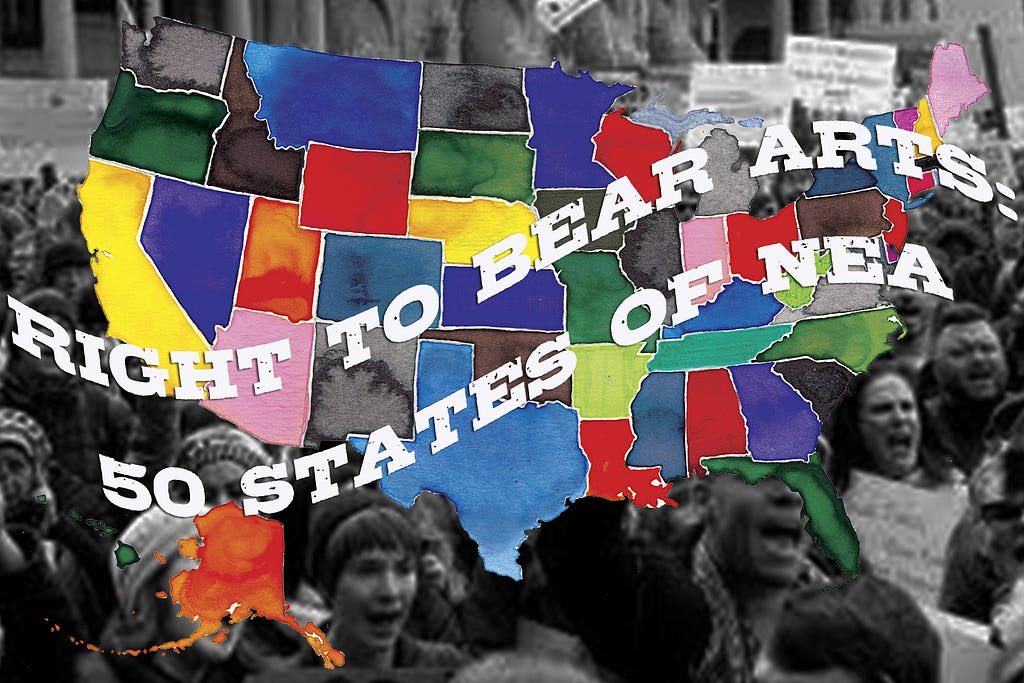
Like many of us, I was appalled at the announcement that the “America First” Budget Blueprint would not only cut but eliminate four independent cultural agencies — the National Endowment for the Arts, the National Endowment for the Humanities, the Institute of Museum and Library Services, and the Corporation for Public Broadcasting.
It doesn’t take long to realise that any spin around these cuts having primarily financial motivation is utterly nonsensical. This is a battle call against cultural and social freedoms, and against the mediums in which free speech and free thinking is encouraged and nurtured. So, too, is it based on the rhetorics of anti-intellectualism, and on the illusion of these monies supporting primarily elite institutions and persons.
So, I set out to debunk this fallacy, going state by state to highlight the vitally important work being done by NEA funded institutions — as well as to amplify the visibility of the intersectional communities they serve. (You can read the introduction to the series here.) We begin, today, with Alaska.
What a joy it’s been to learn about the cultural scene in Alaska! But before we dive right in to the state’s most recent NEA recipients, lets talk a little about the state itself. Alaska is the 3rd least populous (with a population of just 738,432 in 2015) and the least densely populated of the 50 states (at 1 person per square mile; in comparison, over 27,000 people per square mile live in NYC.)
At 14.8%, however, its indigenous population is high — as well as central to the state’s identity. 20 indigenous languages were declared official languages of the state in 2014, and its cultural institutions reflect a commitment to the preservation of these cultures in particular — both vis-a-vis history as well as contemporary support for a range of arts, traditional crafts, and language education.
The first institutions we’ll focus on are based in Anchorage, the city approximately 50% of Alaskan residents call home. These institutions received, in sum, $125,000 from the NEA in 2017.
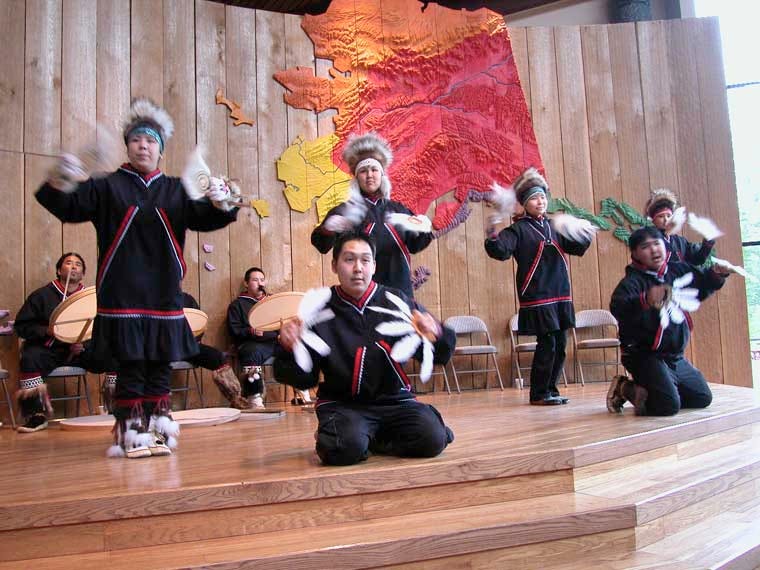
The Alaska Native Heritage Center is a community resource just outside Anchorage, on 26 acres of wooded land, which has as its mission the commitment “to share, perpetuate and preserve the unique Alaska Native cultures, languages, traditions and values through celebration and education.”
Through cooperative programs with universities, schools, and museums, the Center serves not only as a cultural hub but also a clearinghouse for information regarding indigenous cultures, and a learning center for local Native communities.
NEA funding for the center has recently been specifically in support of the Urban Eskimo Language Revitalization Project, promoting “culturally-based fluency through teacher training and development of multigenerational immersion classes and activities.” The grant funded the recruitment and training of teachers, as well as payment for advisors and elders. Curriculum was created for a series of eight multi-generational Inupiaq and Yup’ik classes at the center — all of which, critically, are offered free to participants.
Also supported by NEA funds at the Center is the World Music and Multicultural Drumming Festival, with performance, storytelling, drumming, song, and public workshops featuring Tlingit leader and guest artist Lyle James, along with members of the Woosh Ji.een Dancers.
The Anchorage Concert Association began in 1950, and since then its small staff and volunteers have put on over 700 performances of music, dance, and theater. Now the largest performing arts presenter in Alaska, the association brings visiting artists to both the stage as well as the community, working in tandem with schools and social service organizations through workshops and other outreach events. They are deeply dedicated to not only exposure, but access to the arts, and have given away over 5000 tickets to those who would not have been able to attend.
This round of NEA funding allowed the ACA to bring dancers from LA’s groundbreaking Versa-Style ensemble, storytellers from The Moth, and musicians from the Portland Cello Project, among others, to their audiences.

The Anchorage Museum Association, the governing organization of the Anchorage Museum, received two NEA grants on this round of funding as well, to support their programs and presentations. Founded in 1968, the museum is a vocal advocate for local art and culture, supporting “scholarship, engagement, and investigation of Alaska and the North.”
Specifically made possible is the museum’s Studio 61 initiative, a series of programs exploring the ecology of the Arctic in partnership with University of Alaska, which includes exhibits, curated discussions, product development, and more. In particular, the intitiative “seeks to articulate the distinct meaning, value, and character of place at a time of environmental change.” “61” refers to the latitude of Anchorage and other Northern cities such as Reykjavik, Helsinki, and Oslo — home cities of the artists collaborating on this project, sharing their vision of environmental and cultural change.

Continuing the theme of art and ecology, also funded through the museum is a series of programs exploring the ecology of the Arctic in partnership with the University of Alaska Anchorage’s Alaska Center for Conservation Science. This initiative brings together scholars and artists for exhibits, events, and online presentation, including immersive virtual environments intended to allow visitors to sensorially experience the complexity of the Northern landscape.
Specific support goes to Seattle-based artist John Grade, (whose work you see above) who is creating a sculptural installation in collaboration with multimedia/electronic artist Reilly Donovan that represents a pingo, a naturally occurring land formation in the Arctic tundra. Grade has been working for years investigating the Alaskan landscape, through earlier projects with the museum’s Polar Lab. Now, with Donovan, he’s moved to producing his signature tactile sculptures while also using augmented reality glasses — amplifying the visitor experience with imagery and sound. In conjunction, the artist duo Lead Pencil present “Ephemeral State,” exploring the nature of water through developing technologies.
Our last Anchorage organization is Anchorage Opera, formed in 1962, which was previously honored by the NEA as one of the six most promising opera companies in the United States. Similar to the Concert Association, and following our theme here, the company is deeply committed to commnuity outreach and education. Anchorage Opera also demonstrates a commitment to rigorous, experimental new productions, like the one this funding was earmarked for: composer Tom Cipullo’s A Note on Glory Denied, an opera adapted from the oral history of Colonel Jim Thompson, an American POW who spent nearly nine years imprisoned in Vietnam (adapted from the book by Tom Philpott). The production further engages with the complex and difficult material through panel discussion, lecture-demonstration, and via collaboration with Alaska Public Media (also on the chopping block).
Now we move to a place nicknamed “the end of the road”: the city of Homer, Alaska — two hundred and eighteen miles southwest of Anchorage. “The Halibut Fishing Capital of the World,” Homer boasts a population of just 5,003. But it is also home to the Bunnell Street Arts Center, a vibrant non-profit interdisciplinary arts hub located in an old trading post, presenting monthly exhibits of Alaskan art, hosting artists in residence, artist talks, workshops, leading community-wide activities in public spaces, and providing art instruction in local schools.
NEA funds specifically made bringing the touring exhibit “Decolonizing Alaska,” a possibility for the Center. Featuring works by 31 Alaskan artists, including Sonya Kelliher Combs, Inupiaq painter; Emily Johnson, Yu’pik dancer; Joel Issak, Denai’ana fiber artist, and Melissa Shaginoff, an Athabascan beader, Decolonizing Alaska asks necessary, difficult questions about how stereotypes, colonization and repression has defined Alaska’s art market for many decades, as well as seeking new pathways and possibility for the future of its representation. These young Alaskan artists work in the interstices of indigenous Alaskan materials and crafts as well as with global materials and technologies, speaking directly to both this history and to evolution of form. Artist talks were given at each location along the tour and are available on the Center’s website, as is a Decolonizing Alaska study guide.
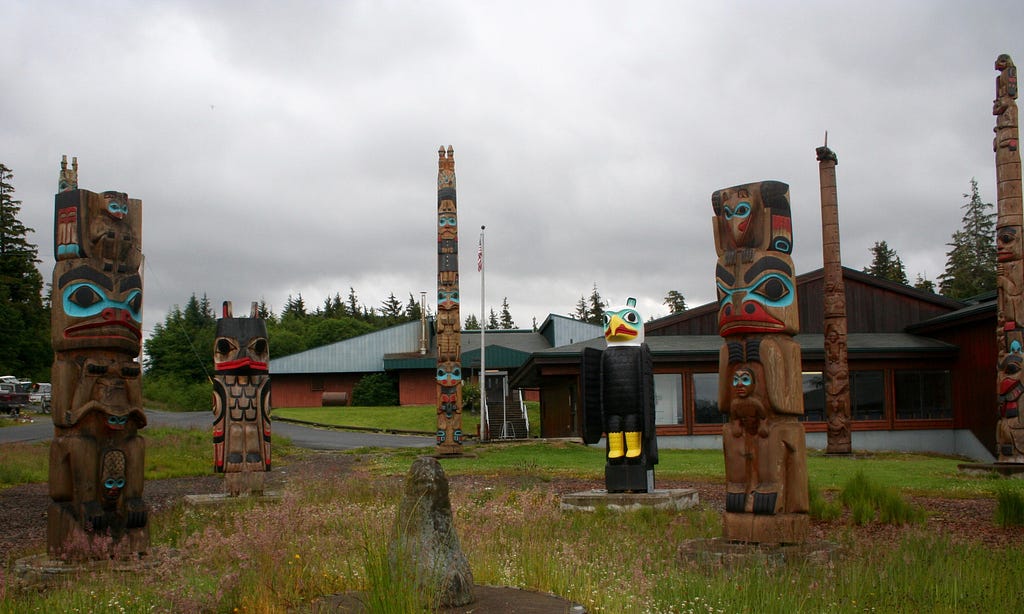
Even smaller in scale than Homer is our next destination, Hydaburg, a city with its most recent population count at just 376. And yet, an organization there received one of the largest NEA grants on this list: the Hydaburg Cooperative Association, a non profit representing the tribe of the Haida people, an indigenous group that have occupied the area for over 12,500 years (and for whom the town is named).
Dedicated to honoring and preserving Haida culture and language, with this grant the tribe specifically supported the creation of traditional carved Haida house posts for their cultural center, pairing master artists with Native apprentices. Weekly carving classes are opened to the general public, where tribal members and other Alaskans are invited to learn traditional techniques and participate in creating these new totems.
We move now to Alaska’s smallest borough, Sitka, which is still huge in comparison to where we’ve just been, with a population of 8,881. Located on Baranof Island, this city was under Russian rule for many years. (Literature appreciating friends, it’s also the focus of Vanessa Veselka’s terrific piece on The Atavist, Fort of Young Saplings, which is totally worth a side-read.)
In Sitka we find the Island Institute, who sponsors the incredible Tidelines Journey Residency program, a nomadic group artist residency featuring visits to small, remote, island and coastal communities along the Alaska Marine Highway, wherein the artists both produce and present work, engaging with local audiences.
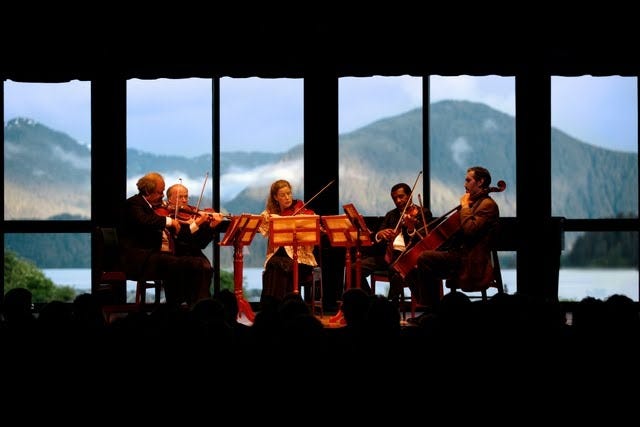
Sitka is also the site of the Sitka Summer Music Festival, founded in 1972 by violinist Paul Rosenthal, who was its tireless advocate until 2011. With help from the NEA, the Festival continues to thrive, and has grown to include events in Sitka throughout the entire month of June, partnering with 25 business and community partners. They now also sponsor a concert series in Anchorage in September and February, with visits to schools, free public performances, and visits to the Hiland Women’s Prison. Through Across Alaska, this funding’s focus, Festival musicians are also able to travel to other, more rural communities (33 to date) where they perform, always including outreach to schools, hospitals, and retirement centers.
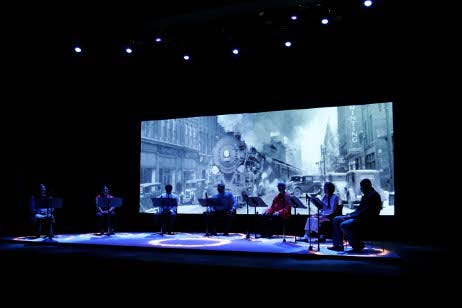
Our last stop is Juneau, Alaska’s capital, with a population of 31,000, where the NEA supports the Arts and Humanity Council’s vital programs, as well as the Juneau Jazz & Classics Festival, an annual event with more than two weeks of festival programming. In particular, the Council’s funding is supporting an artist residency from visionary theater artist Ping Chong, whose company’s work engages deeply with social justice and civic issues, using oral history, puppetry, projection, and more. For the Juneau residency, the company is working directly with the population in a geographically remote community, gathering stories from the region’s historically indigenous district, which serves as the production’s core material. The new work, “Undesireable Elements: Juneau Histories,” will feature Juneauites as well as company members, and work in collaboration with local theater educators.
As an artist and educator, as well as a citizen (and especially as one who has spent the large portion of my life with extremely limited resources), I can say without reservation that I owe my growth and evolution not only as a creator but as a thoughtful, engaged human being to the types of organizations listed here — to the types of organizations that strive to survive in all our states. It’s a really exciting thing to learn about what’s happening far from home —it’s heartening, ironically, given that the impetus to this project was the threat to cut the funding for these life-giving works.
I hope you’ll continue to journey with me! And if in the interim, you’re curious to know more about what’s being funded in your state (or anywhere across the US!) this information is publicly available here, on the NEA website. Next stop, Alabama!
An invitation to friends and readers: this is a probono project, on top of a busy publishing schedule and my teaching job. That said: if you’re interesting in participating, I’d be more than happy to have you join me. If you’d like to pick a state and write on its grantees, please be in touch!
Right to Bear Arts :: 50 States of NEA :: ALASKA was originally published in DrunkenBoat on Medium, where people are continuing the conversation by highlighting and responding to this story.
